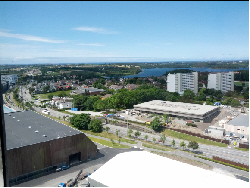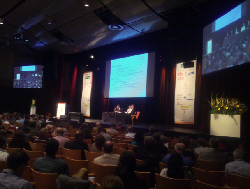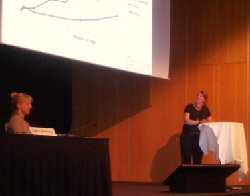



European Poultry Conference Explores Challenging Welfare Issues
Welfare issues of modern broilers and laying hens were among the topics discussed at the recent European Poultry Conference, reports Dawn Scholey of Nottingham Trent University for ThePoultrySite.The 14th European Poultry Conference took place in Stavanger, Norway, from 23 to 27 June with approximately 1,000 attendees from all over the world. This conference included both plenary sessions with invited speakers and parallel sessions of short oral presentations. The three plenary sessions were all followed by a group discussion with the invited panel.

Limits to Broiler Growth
The plenary session on Wednesday morning was entitled 'Limits to growth in broilers', which introduced the topic in general terms before moving onto specific issues concerning broiler growth, namely skeletal development and meat quality.
Welfare and breeding in broilers
The first speaker in this session was Professor Marian Dawkins who gave an overview on the welfare considerations of broiler production. She shared her concerns about the lack of welfare considerations in the drive for global food security and sustainability.
Although improving efficiency may affect welfare, it is not clear whether there really is a conflict between welfare and efficient production and the speaker was keen to point out that many aspects of good welfare make sound economic sense; for instance reducing foot pad dermatitis (FPD), mortality, lameness and disease all have cost benefits and there may be the added advantage of lowering medication use and reducing the risk of human infections.
*
"Breeders and farmers are interested in welfare more than people realise"
The specific areas for concern highlighted in this presentation were feed deprivation in adult birds, and the rapid growth of young birds, but Professor Dawkins made the point that although there may be limits of what is genetically possible without compromising welfare, we currently do not know where the limits lie and that we may have more options that we think. For instance, a high juvenile growth rate occurs in nature, with wild birds often showing a differential in their growth where the rapid start slows towards reproduction.
It is known that there are genes controlling growth at different ages, so it was suggested that this area had potential for future research, with the challenge being to produce a broiler breeder which needed no feed restriction but was still capable of producing competitive offspring.
Progress in broiler selection: benefits and limitations as assessed by digestive function
The second speaker in this plenary session was Bernard Carré from INRA, who was speaking on the selection of broilers for digestive function. He suggested that the most important areas for genetic selection were lower feed intake and higher meat production. The latter was identified as a particular issue as the higher proportion of meat yield can be linked to a reduction in organ size, which may have a detrimental effect.
In the study, Dr Carré reported he noted that daily feed intake is proportional to the size of the supply organs such as the digestive tract, liver and urinary system. However, the challenge for geneticists is that the relationship of feed intake to bodyweight and to organ weight are moving in opposite directions – increased organ size is necessary in larger birds, but what is seen is a relative reduction, which may reduce their function. In conclusion, Dr Carré stated that for broilers to continue to grow, the meat yield as a proportion of bodyweight needed to remain constant and not be at the detriment of the birds’ organs.
Skeletal development in fast-growing broilers
Dr Rosalina Angel from Maryland University then spoke on skeletal development in fast growing broilers. She concentrated on the differences in bone characteristics and related this to what she has observed in the field. In the US, it was noted that the heavy broilers had issues with lameness, with losses of around two to six per cent. The larger birds have a centre of gravity which is different from their wild counterparts and puts the head of the femur under a lot of pressure; plus the rapid growth of the broiler means that the skeleton is not mature at six weeks.
Modern broilers have longer and wider bones than historical breeds but they are much more porous. The speaker went on to discuss that chicks at hatch have very low stores of minerals, and a way needs to be found to either feed the breeder or the egg so that chicks are not hatched in a deficient state. The lack of phosphorus is a particular problem as the yolk contains a large amount of calcium so the ratios are not optimum for producing strong bones.
However, Dr Angel concluded, nutrition could only do so much with respect to improving lameness and skeletal issues. In the field, it was observed that lots of birds were being seen with femoral or tibial head necrosis and that it was becoming a big issue in the American flocks.
Meat quality in fast-growing broilers
The final speaker in this session was Dr Massimiliano Petracci from Bologna University who spoke about the effect of increasing bird size on meat quality. The increased breast size in modern broilers has led to increased fibre size and more breast meat abnormalities and fast growing birds are less able to deal with heat stress, which can cause meat quality problems. The main issues are deep pectoral myopathy (DPM), pale soft exudative (PSE) meat, white striping and wooden breast, and these are most common in large birds, with high breast yield.
Treatments suggested included genetic selection, minimising pre-slaughter stress and treating the meet in the processing plant – specifically mixing small quantities of affected meat with unaffected and avoiding products with a high water content.

Role of Nutrition in Welfare Issues Discussed
The plenary discussion began with a general question on whether problems could be solved with nutrition. The panel stated that in regards to skeletal problems, the issues are driven by genetics, and the job of nutritionists is to ameliorate the problems as much as possible. This was also reiterated for meat quality; although antioxidants can be given, these only mitigate the issues as opposed to solving them. A delegate from the floor suggested that the industry needs honesty about what is possible for geneticists to achieve.
Dr Rosalina Angel was asked whether there was an effect of stocking density on leg issues, to which she responded that in countries with higher stocking densities, leg issues were not necessarily seen and that she felt that mobility was more important, and that current husbandry practices were exacerbating the problems.
She was also asked whether she felt that vitamin D was important, and she replied that although experimentally, supplementation improves the problem, the levels used were high in the US and the same improvements were not always seen in practice.
To a question about mitigating flock differences, Dr Angel replied that birds are not homogenous, they respond to deficiencies differently, however they all end up with lameness issues eventually.
Professor Marian Dawkins was asked what areas welfare could make the most difference and how we can improve dialogue between farmers and welfare scientists. She replied that breeders and farmers are interested in welfare more than people realise, and she feels that starting from common ground, such as animal health, will go some way towards reducing antagonism.
The two areas she identified as important to making a difference to both welfare and economics were foot pad dermatitis in broilers and overall mortality in laying hens.
Focus on Hen Welfare
On Wednesday afternoon, there was an interesting parallel session on layer hen welfare, when three authors presented original communications reporting studies with emphasis on keel damage in laying hens.

Ina Kempen spoke about her ongoing study to quantify the prevalence of keel bone damage and breaks in Belgian aviaries.
She noted that 13 per cent of the hens in her study already had keel bone deformities by the start of lay at 18 weeks, which increased to 24 per cent by 35 weeks. She was able to palpate breaks in 20 per cent of hens at 35 weeks but noted there was massive variation between flocks, which she suggested was due to husbandry procedures, specifically moving birds around the aviary too abruptly.
This study is ongoing and will assess the same flocks up to the end of lay to study the damage post mortem.

Ariane Stratman from Berne University in Switzerland considered genetic selection as a tool to improve the incidence of keel fracture. Using hens genetically selected to have high and low bone strength, she compared egg parameters and keel damage.
The high bone strength line had fewer fractures but lower egg quality, leading the researcher to conclude that although genetic selection could be successful for fracture reduction, it needs to be as part of a multifactorial approach to include housing design and nutrition.
Sabine Gebhardt-Henrich investigated whether birds with keel bone fractures are those with weaker bones to begin with. This appeared to be the case from her study, as hens with intact keel bones had higher bone mineralisation and the bones were more difficult to bend. The fractures were graded for severity and the worst ones were found in the birds with the weakest bones. There was also variation between flocks, suggesting that in those seeing a lot of keel damage, there may be an underlying bone weakness in the flock which is at the root of the problem.
July 2014








